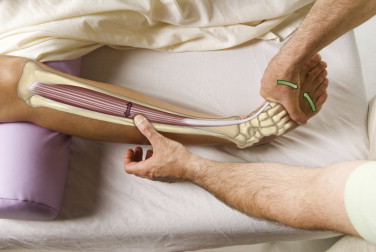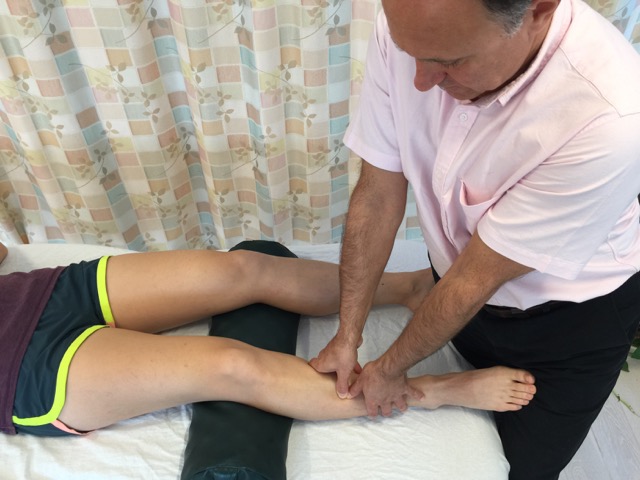Manual therapy treatment for shin splints

Palpation of the tibialis anterior. Permission Joseph E. Muscolino. The Muscle and Bone Palpation Manual – with Trigger Points, Referral Patterns, and Stretching, 2ed (Elsevier, 2016).
The first goal of manual therapy treatment for shin splints is to relieve the tension of the involved musculature by lessening baseline muscle tone and eliminating any trigger points that might be present. The second goal is to treat swelling, if present. If overpronation is present as a contributory factor, this should also be addressed.
Relieving global muscle tension and trigger points is done by performing soft tissue manipulation (massage), heat, and stretching. As a general rule, deep stroking massage is very effective. The direction of these strokes can be along the length of the muscle or cross fiber; generally cross fiber work is more beneficial for breaking up patterns of fascial adhesions. If soft tissue manipulation is done near the tibial attachment, the depth of pressure should likely be less, and the strokes should be directed from distal to proximal, to help direct venous blood flow back to the heart. Deep stroking and/or sustained compression are effective for myofascial trigger points. If heat is done to help relax and loosen the musculature, it should be applied with the person’s leg elevated, to lessen the likelihood that the heat will increase swelling in the compartments of the leg.
Stretching the musculature is achieved by moving the client’s/patient’s foot into the joint actions that are opposite the muscle’s concentric actions. To stretch the tibialis anterior, the foot should be stretched into plantarflexion and eversion. To stretch the soleus and tibialis posterior, the foot should be moved into dorsiflexion and eversion.
Cryotherapy (ice) should be used to reduce any swelling that might be present with shin splints. Ice can easily be applied for anterior shin splints because the tibialis anterior, and indeed most of the anterior dorsiflexor compartment musculature, is superficial. Icing should be applied where the tibialis anterior attaches along the lateral border of the tibia. Cryotherapy is more difficult logistically and somewhat less effective if the client/patient has posterior shin splints, especially if the involved musculature is the tibialis posterior in the deep posterior compartment.
Because more severe cases of shin splints can possibly involve some tearing of the tendinous fascial tissue of the muscle at the site of attachment to the bone, an argument can be made for more aggressive soft tissue manipulation (e.g., deep cross fiber strokes or Graston Technique), the purpose of which is to actually cause swelling to promote fibroblastic activity to help mend any tearing that has occurred. The value of this approach must be weighed against the fact that swelling will be increased. Therefore, this technique should not be employed if swelling is the greater pathologic factor of the client’s/patient’s condition.
Although shin splints does not directly involve any joints, it is always a good idea to assess via motion palpation the non-axial joint play of the tarsal and metatarsals of the foot, especially if the condition is long-standing because they might contribute to stress on the musculature of the leg. If joint restrictions are found, joint mobilization (arthrofascial stretching) should be done.
Finally, because shin splints is ultimately a condition of overuse of musculature, once the acute phase has passed, it is always a good idea to strengthen the involved musculature so it can better handle in the future the stresses that will be placed upon it.
Summary of Manual Therapy Treatment Protocol of Shin Splints
| 1. Soft tissue manipulation, heat, and stretching of the involved musculature. |
| 2. Cryotherapy along tibia for anterior shin splints |
| 3. If tearing is present and swelling is not the major concern, assertive soft tissue manipulation along the attachment of the involved musculature to promote fibroblastic activity. |
| 4. Mobilize (arthrofascially stretch) compensatory joint hypomobilities of the tarsals and metatarsals, if present. |
| 5. Strengthen involved musculature |
Precautions/contraindications for shin splints
During the acute stage of shin splints, nothing should be done that would increase swelling of the periosteum; therefore, any soft tissue manipulation should be gentle in force. When performing soft tissue manipulation to the leg, caution should be exercised so that excessive pressure is not placed over the tibial nerve in the popliteal region and posterior leg, or over the common fibular nerve near the fibular head. And before engaging in deep pressure massage into the posterior leg, it is important to rule out deep vein thrombosis.



